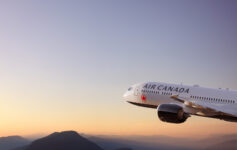
Air Canada provides us with a textbook example of how to handle an unruly passenger onboard who tried to open the 787-9 aircraft door mid-flight. No diversion was necessary…it rarely is.
The Right Call: Air Canada Flight Does NOT Divert After Scary Door Incident Over Atlantic Onboard 787-9
On Sunday, January 21, 2024 Air Canada flight 855 from London (LHR) to Toronto (YYZ) experienced a disturbance onboard. A male passenger, described as a senior citizen, attempted to rip open the aircraft emergency exit door while the plane was at cruising altitude.
It is not clear what prompted the action, but he was restrained by members of the flight crew and fellow passengers and confined to his seat for the remainder of the flight. After landing on time at Toronto Pearson International Airport, passengers were ushered off the aircraft and authorities boarded. The man was removed.
An investigation determined the man was “in a state of crisis and confusion” and his actions were not deliberate. He was not charged and has since been reunited with his family.
Air Canada almost casually brushed off the incident:
“Our crews are experienced and managed the situation appropriately, allowing the flight to continue normally to its destination. As per procedures, authorities met the aircraft.”
The good news is that it would require superhuman strength to open an aircraft door at cruising altitude…it’s impossible for you and me. Try as you might, the doors are mechanically locked and the strong cabin pressure creates a force that cannot be overcome.
That aside, I greatly appreciate the way Air Canada handled this incident. No diversion. No unnecessary theatrics onboard. It seems to me that in almost every case of a diversion, the money, time, and inconvenience of such an action ultimately do not justify it. While I do appreciate why a captain would not want an unruly passenger to remain onboard and risk further harm to others, restraining a passenger and posting sentries to ensure there is no movement strikes me as a cost-effective solution that prompted not only safety, but reduces inconvenience to the other passengers onboard.
CONCLUSION
An Air Canada flight chose not to divert after a passenger attempted to open the emergency exit door during the flight. While the passenger may well have been a risk, that risk was effectively mitigated by restraining him in his seat: a diversion was not necessary here and is rarely necessary.
image: Air Canada




The response certainly was proportional. Should a response be equally proportional when the person is a large obsessed lunatic rather than a confused old man?
@Christian … Excellent question . Everyone was very lucky when the non-flying pilot in the jump seat ate all the mushrooms , yeah ? He ought to have been restrained from the get-go by a prize-fighter or wrestler on board .
We should all pack DUCT TAPE in our carry-on…
I think the Canadian pilots took a common sense approach not to divert and cost the airline thousands of dollars in a new flight plan and extra fuel… I think the American way of thinking is different.
That go a little far down the “Creepy, possible stalker or sexual predator” road but flight crews absolutely should carry a roll.
Be compassionate toward your elderly relatives. They need more help, more assistance with travel, and more patience. Even the NY Post was circumspect about this incident. Be kind and remember one day this could be you.
Thankfully there wasn’t a diversion needed but plan for your relatives so no such action will be necessary.